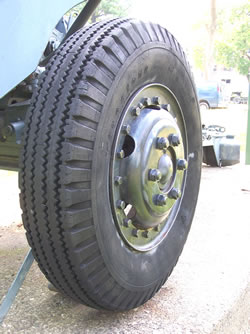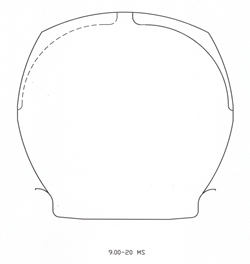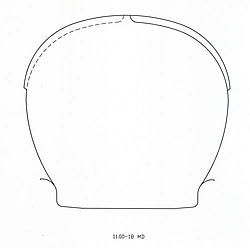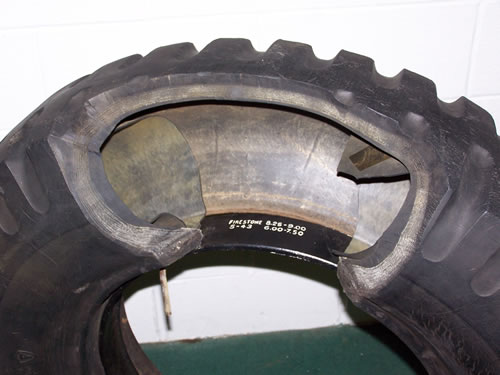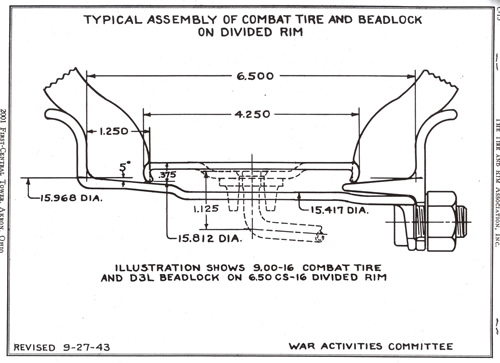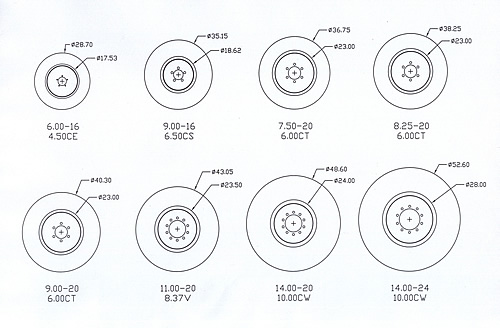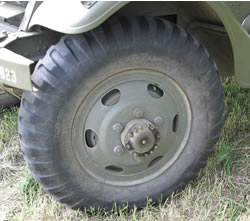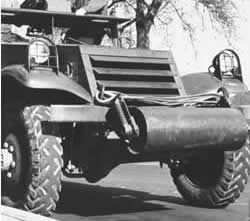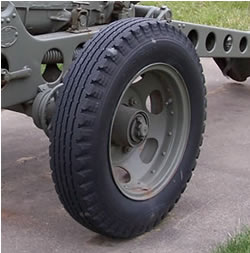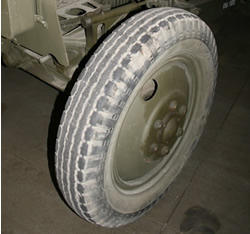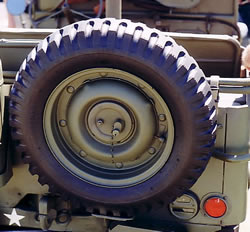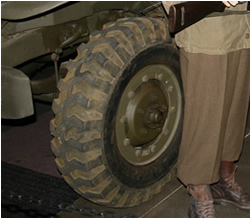|
U.S.
Army Pneumatic Tires of World War II |
 |
By Kurt LaughlinIntroductionThe style and dimensions of the tires used on American military vehicles have been controversial for years, especially with regard to scale modeling. I remember articles in the old AFV-G2 magazine of the 1970's on which tires were used for what, and today there are repeated discussions regarding the accuracy of the tires used on kits such as the Tamiya M8 armored car, AFV Club 155mm gun, and DML 105mm howitzer. Fortunately definitive data exists in the holdings of the US Army Military History Institute at Carlisle Barracks, PA; the National Archives at College Park MD; in modern military and government specifications, and on surviving vehicles. It is possible to create a reasonably complete picture of tire configurations used during World War II from this data. Tread StylesThere were four common tread styles in use on tactical vehicle tires: Highway, Directional, Mud and Snow, and Military Desert. Only one had any relevance as to how the tire was constructed.
Highway tread, also known as HW, civilian, or truck and bus, was the tread commonly seen on civilian trucks, with sharp shoulders and a crowned and grooved tread surface. Developed for good wear and traction on paved surfaces, it could easily clog with mud in cross-country travel and become essentially a smooth balloon tire. It was used primarily for rear area vehicles and unpowered axles (trailers and towed weapons) but was regularly substituted for other treads during the War because of shortages. Directional
tread was a descendent of agricultural or tractor tires with chevron lugs. It
was commonly seen on half-tracks and scout cars early in war. This tread was recommended
to be the "maximum traction" tread style January 1942 (OCM 17704) but
the non-directional Mud and Snow tread was adopted instead in March (OCM 17926),
and the directional tread was rarely seen after that. The biggest problem with
this tread style was that the tires became "handed" and could only be
used on one side of the vehicle.
Mud and Snow, also known as MS or NDMS, was the standard tactical tread for the Army (OCM 17926). It provided good traction with its straight, alternating lugs and was not required to rotate in a particular direction, unlike a directional tread. Its cross-section was similar to the Highway tread, with a crowned tread and sharp shoulders. Military Desert, also known as MD, was the tread style developed specifically for desert and amphibian applications where good traction in soft terrain was required (OCM 19547). It appeared similar to the Mud and Snow tread but was notable for having rounded shoulders. Unlike the other treads, MD tires had a specific construction that was more flexible than the other types. Tire ConstructionTire construction was of three types: Standard, Combat, and Military Desert. The first two were designed to maintain the tire's shape (to varying degrees) when deflated while the MD construction was intended to flatten considerably and distribute the carried load over a larger area. Only the MD construction implied a specific tread type. Standard and Combat construction could be used with various tread styles. Standard construction used a combination of bias wrapped cords and sheet rubber layers with a molded-on tread. This was the normal peacetime method with a balance between economy (using less material) and durability (using more). When deflated or under inflated, these tires would flatten and bulge the sidewalls. Running them in this condition would quickly destroy the sidewalls and ruin the tire.
Combat construction was adopted as standard in October 1941 (OCM 17285). They were developed as "run-flat" tires that would allow continued operation for 75 miles (eventually reduced to 40 miles) even after being punctured by bullets or shell fire (OCM 19747). These tires used significantly more rubber (50-60%) in their sidewalls to maintain rigidity, along with beadlocks, a metal band that went inside the tire and pressed the beads outward against the rim, which added to sidewall rigidity. (The beadlocks also prevented slipping on the rim.) Because of the rigid construction and beadlocks normal one-piece wheels where the tire was stretched over and between the flanges could not be used. A two-piece divided rim was concurrently developed that effectively split the wheel in two (much like most model kit wheels) and was assembled from either side of the tire. While it was possible to change a tire without removing the wheel from the vehicle using a divided rim this practice was apparently little used. Divided rims could also be used with standard tires.
Military Desert tires were similar to Combat types in that they used a divided rim and locked the tire to the wheel, but instead of maintaining their shape while deflated they were designed to flatten in a controlled manner and remain durable when running under-inflated. It
should be noted that the vehicle tires of today are typically of radial ply construction,
not the bias ply of WW II. Thus, while even properly modern inflated tires will
have bulged sidewalls, in WW II there should be no noticeable sidewall bulging.
Both radial and bias ply tires will have a small flat spot in contact with the
ground, however. Tire SizesThe only
notable thing about tire sizes is that the numbers do not provide a means of determining
the outside diameter of the tire. For example, a 9.00-20 tire is not 2 x (9.00)
+ 20 = 38 inches in diameter. (40.1 to 40.7 inches are the actual limits.) The
first number (9.00) is the nominal section width, not height, so unless the tire
cross-section was square or circular the height will be different. The second
number is the nominal rim size, representing the inside diameter of the tire or
the outside diameter of the rim between the flanges. Unfortunately this is not
something you can measure once the tire is mounted on the wheel. Notes on UsageGiven its druthers, the Army would have used Combat tires exclusively on all tactical vehicles and equipment; in fact this was specified in 1941 (OCM 17285). However, the increased cost, greater rubber usage, and reduction in production capacity of Combat tires prevented their uniform employment. Reductions in the application of Combat tires were authorized as the rubber supply situation became acute in the late 1944:
Applications by SizeSurprisingly, there was little standardization of sizes among the various vehicles used by a particular type of unit. For example, prime movers and the trailers or weapons they towed frequently had different tire sizes! The table below lists the tire sizes and constructions used for the more common WW II vehicles. Construction (and to a lesser extent wheel type) is indicated by S, C, or MD. 8.25-15 6.00-16 8.00-16 9.00-16 11.00-18 6.00-20 7.50-20 8.25-20 9.00-20 11.00-20 12.00-20 14.00-20 10.00-22 7.50-24 13.00-24 14.00-24 18.00-24 SizesThese
sizes are those that can be documented from wartime or other specification:
NDMS
and MD data was taken from a post-war military specification and may differ slightly
from the wartime values.
References
|
 |
 |
 |
 |
 |
 |
 |
 |
 |
 |
 |
 |
|
